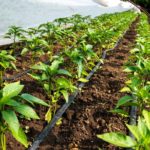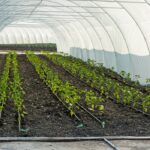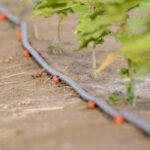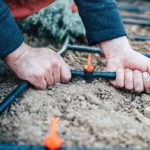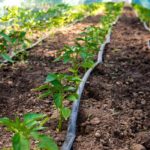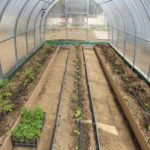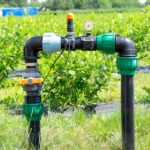When we think of irrigation systems, the image of sprinklers typically comes to mind, since they’re a pretty visible and common method of automated watering. But drip irrigation is actually a more efficient way of delivering the exact amount of water needed by each plant. When properly designed, installed, operated, and maintained, a drip system can prove to be a valuable asset to your garden.
A drip irrigation system efficiently delivers water directly to plant roots using tubes and emitters that are placed alongside the plants. With this method, there’s hardly any water lost due to evaporation. Different types of drip systems can be applied according to specific needs and requirements.
Choosing the ideal method of irrigation will help you maintain a lush, green garden. And although sprinklers may seem easy to use compared to traditional watering cans, they’re still imprecise and inefficient. Let’s take a look at drip irrigation in detail to see whether it’s the right system for you.
What Is Drip Irrigation?
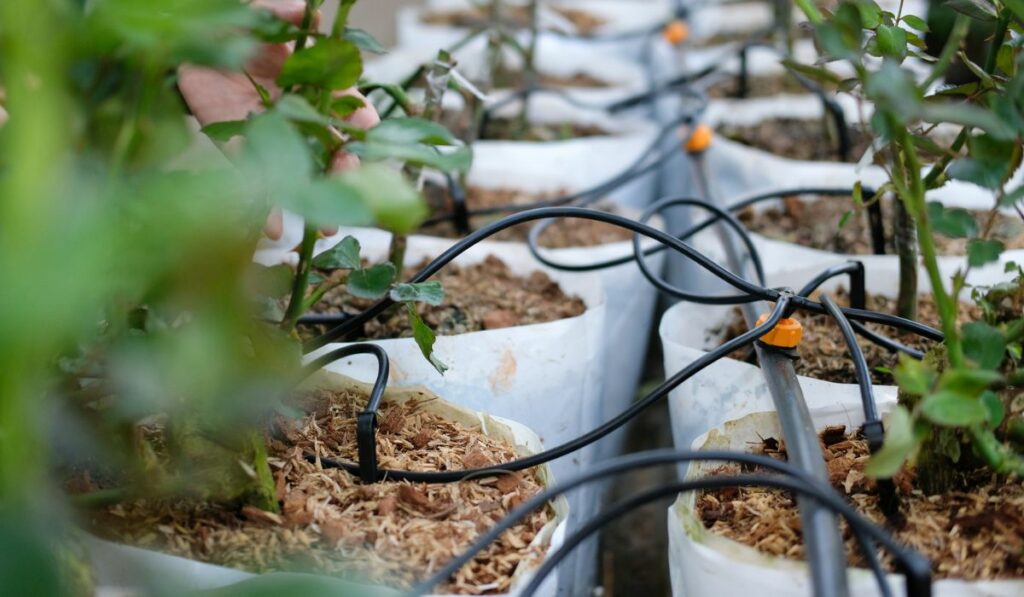
The typical drip irrigation system (on Amazon) is an efficient method of delivering water and nutrients directly to the root zone of your plants, at the right time and in the right amounts.
This ensures that each plant gets what it needs exactly when it needs it in order to be healthy and happy. This system helps gardeners to save water as well as energy and fertilizers while enjoying higher yields.
What Are the Benefits of Drip Irrigation?
Unlike other methods of irrigation, the drip irrigation system is almost 90% efficient in using the amount of water applied to the plants. That’s just one of many benefits; here are some others:
Saving Water
Drip irrigation systems are designed to minimize water waste. As water is applied directly to the plant roots, there’s very little evaporation. In addition, this system uses almost 50% less water compared to conventional watering systems.
Eliminating Weed Growth
This system supplies water directly to plant roots, which means there’s hardly any additional water for weed growth. As a result, there are fewer weeds in your garden to deprive your plants of soil nutrients and water.
Extending the Watering Time
With drip irrigation, water seeps slowly into the depths of the ground to reach the plant roots. The slow application of water ensures there’s no runoff, which in turn slows down the soil erosion process.
Preventing Plant Diseases
Excess moisture can lead to many problems such as the development of fungal and other diseases, and pest and insect problems. In a drip irrigation system, the plant leaves remain dry, which keeps the development and spread of these diseases in check.
Flexibility
It’s very easy to make adjustments or modifications to a drip irrigation system to fit the needs of your garden. You can place emitters according to the landscape and add more emitters around your plants as they grow.
What Are the Different Types of Drip Irrigation?
The following are the different types of drip irrigation systems:
Porous Soaker Hose
The porous soaker hose (on Amazon) is one of the best methods of watering plant beds or rows of shrubs. The water is directed towards the plant roots, which allows the soil to absorb all the water. That’s why there’s very little evaporation. This system is quite popular among gardeners because of its water efficiency and eco-friendliness.
The porous soaker hoses are typically made from recycled car tires. There are holes along the length of the hose that drip water slowly to keep the plant roots moist. The soaker hoses can last for up to 10 years or longer.
It’s important to note that soaker hoses aren’t the best option when it comes to watering lawns. The soaker hose is a straightforward method of watering plants, and it’s very rare to encounter any problems in its installation or use.
However, it’s important to ensure that there’s no water left inside the hose when it’s not in use. Water left inside the hose for longer periods can become the breeding ground for mosquitoes, as they typically lay their eggs in water.
Raindrip Drip System
The best thing about the Raindrip system (on Amazon) is that after the initial setup, you don’t need to do much. You just need to connect the timer to the faucet, attach the supply line, and place it around your garden. The automated system will do the rest.
Compared to traditional watering methods, the Raindrip system distributes water more efficiently and helps to save time, money, and water. This system is highly suitable for use during a drought or in areas where there are watering restrictions.
The Emitter Drip System
An emitter drip system is a suitable option if your garden has landscaped areas or shrubs. This system requires a long hose that can be installed above or below the ground. You’ll need to drill tiny holes in the hose to allow water to drip into the soil.
The distance between holes should be 12 to 15 inches. You can install this hose above ground by creating a path along your plants, or bury this hose 2 to 3 inches under the ground. Make sure that you choose a good quality hose that will last a long time.
Micro Mist Sprinklers
Micro mist sprinklers (on Amazon) are quite similar to traditional sprinklers, but the only difference is that they use less water. These sprinklers are typically used in fruit orchards and vineyards to water the trees.
These sprinklers constantly deliver water mist to a large area. As a result, the ground in such fields feels like it’s covered with dew all the time. This system is only suitable in large areas where constant moisture is needed.
Is Drip Irrigation Better for Plants Than Other Methods?
When you use sprinklers to water your garden, the water travels in the form of spray through the air. As a result, a large amount of it evaporates before it even touches the ground. Sprinklers are suitable to spray water over large areas, but their installation can cause your water bill to go up.
The drip irrigation system is better for plants because the water goes directly into the ground, which means very little is lost due to evaporation. This system also makes it possible to control the amount of water being delivered to the plants according to their unique needs.
In this system, water is applied to the plant roots, which keeps the stems and leaves dry. This eliminates the environmental conditions that promote the spread of diseases and insect infestation.
What Are the Downsides of Drip Irrigation?
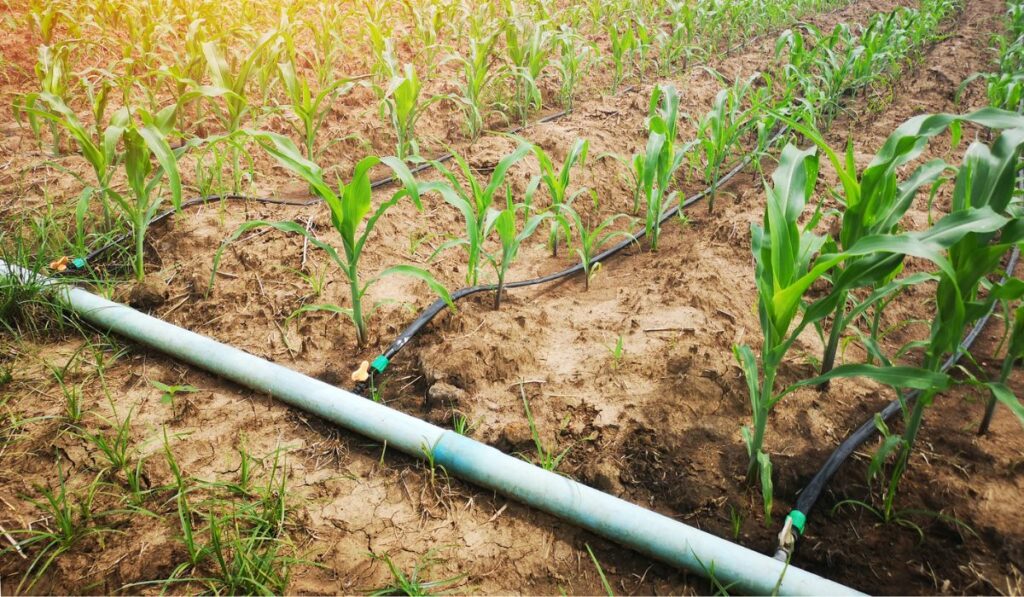
The various drawbacks of drip irrigation system include:
- Excessive heat from the sun can cause damage to the tubing.
- Degraded plastic tubes can affect the fertility of the soil.
- The installation process needs time and some knowledge about water management.
- Improper installation can lead to a waste of water, time, and heat.
- Tubes can get clogged, which can disrupt the water flow and cause the roots to dehydrate.
- Regular maintenance is required for the efficient performance of the system.
- High upfront costs can be a deterrent.
- Regular capital is needed to replace emitters and tubings that become clogged or develop leaks.
How Do You Maintain a Drip Irrigation System?
The efficient performance of a drip irrigation system depends on regular maintenance. Careful monitoring and regular maintenance is the key to avoiding clogging, pressure mismanagement, and system deterioration.
Make sure to clean and flush your drip tubes and emitters regularly to keep them free of debris and mineral buildup.

